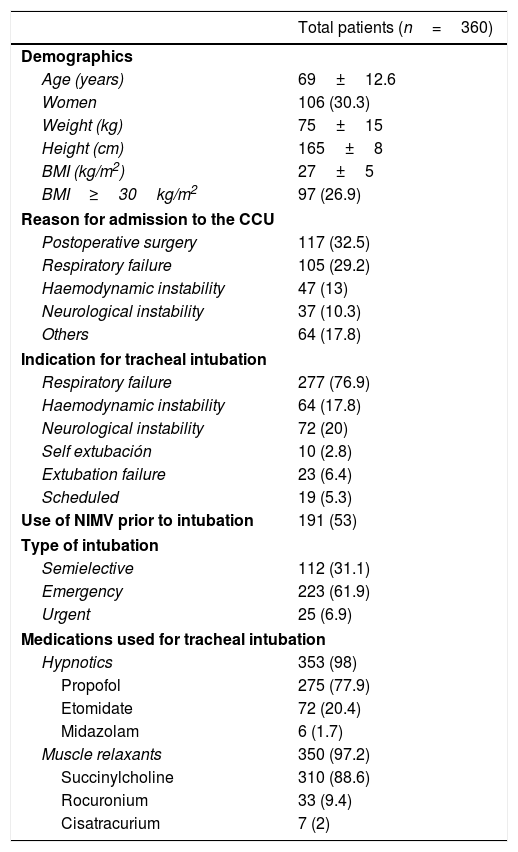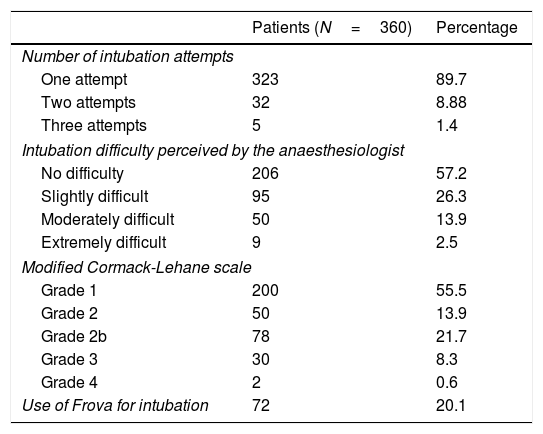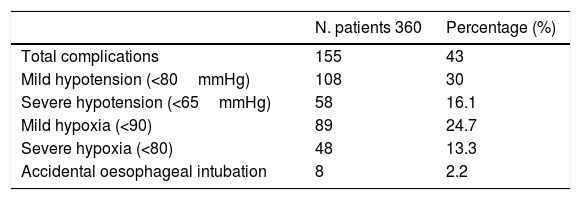Tracheal intubation in the intensive care unit is associated with a high incidence of difficult intubation and complications. This may be due to a poor view of the glottis during direct laryngoscopy. The aim of this study is to determine if there is a relationship between laryngoscopy view using the modified Cormack-Lehane scale with the incidence of difficult intubation and complications.
MethodsAll patients who were subjected to tracheal intubated with direct laryngoscopy in the intensive care unit over a 45-month period were included in the study. In all patients, an evaluation was made of the laryngoscopy view using the modified Cormack-Lehane scale, as well as the technical difficulty (number of intubations at first attempt, operator-reported difficulty, need for a Frova introducer), and the incidence of complications (hypotension, hypoxia, oesophageal intubation).
ResultsA total of 360 patients were included. When the grade of the modified Cormack-Lehane scale was increased from 1 to 4, the incidence of first success rate intubation decreased (1: 97%, 2a: 94%, 2b: 80%, 3: 60%, 4: 0%, p<.001), the incidence of moderate and severe difficulty intubation increased (1: 2%, 2a: 4%, 2b: 36%, 3: 77%, 4: 100%, p<.001.), as well as the need for a Frova guide (1: 7%, 2a: 8%, 2b: 45%, 3: 60%, 4: 100%, p<.001). When the grade of the modified Cormack-Lehane scale increased from 1 to 4, the incidence of hypoxia <90% increased (1: 20%, 2a: 20%, 2b: 28%, 3: 47%, 4: 100%, p=.0073), as well as hypoxia <80% (1: 11%, 2a: 10%, 2b: 12%, 3: 27%, 4: 100%, p=.00398). No relationship was observed between the incidence of hypotension and the grade of the modified Cormack-Lehane scale (p=ns).
ConclusionsDuring tracheal intubation in the intensive care unit a close relationship was found between a poor laryngoscopy view using the modified Cormack-Lehane scale and a higher difficulty technique of intubation. A relationship was found between the incidence of hypoxia with a higher grade in the modified Cormack-Lehane scale. No relationship was found between hypotension and the modified Cormack-Lehane scale.
La intubación orotraqueal en las unidades de cuidados críticos está asociada a una frecuencia alta de dificultad y complicaciones. Una mala visión glótica durante la laringoscopia directa podría ser la causa. El objetivo de este estudio es evaluar si existe una relación entre la visión laringoscópica valorada por la escala modificada de Cormack-Lehane y la dificultad de intubación y la aparición de complicaciones.
MétodosSe incluyeron todos los pacientes intubados con laringoscopia directa en la Unidad de Cuidados Críticos durante un periodo de 45 meses. En todos los pacientes se valoró la visión glótica medida con la escala modificada de Cormack-Lehane, la dificultad de intubación (intubación al primer intento, dificultad valorada por el anestesiólogo, uso de la guía de Frova) y la aparición de complicaciones (hipotensión, hipoxia, intubación esofágica).
ResultadosSe incluyeron 360 pacientes. A medida que aumentó el grado en la escala modificada de Cormack-Lehane, disminuyó la incidencia de intubación orotraqueal al primer intento (1: 97%, 2a: 94%, 2b: 80%, 3: 60%, 4: 0%, p<0,001), aumentó la incidencia de intubación con dificultad moderada o severa (1: 2%, 2a: 4%, 2b: 36%, 3: 77%, 4: 100%, p<0,001), así como la necesidad de uso de Frova (1: 7%, 2a: 8%, 2b: 45%, 3: 60%, 4: 100%, p<0,001). A medida que aumentó el grado en la escala modificada de Cormack-Lehane, aumentó la aparición de hipoxia <90% (1: 20%, 2a: 20%, 2b: 28%, 3: 47%, 4: 100%, p=0,0073) y la hipoxia <80% (1: 11%, 2a: 10%, 2b: 12%, 3: 27%, 4: 100%, p=0,00398). No encontramos relación entre la aparición de hipotensión y el grado en la escala modificada de Cormack-Lehane (p=ns).
ConclusionesDurante la intubación orotraqueal en la Unidad de Cuidados Críticos hemos encontrado una estrecha relación entre una mala visión glótica valorada por la escala modificada de Cormack-Lehane y una mayor dificultad de la técnica. La incidencia de hipoxia se relaciona directamente con un mayor grado en la escala modificada de Cormack-Lehane. No hemos encontrado ninguna relación entre la hipotensión y la escala modificada de Cormack-Lehane.
















